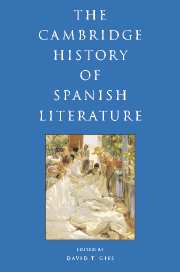Book contents
- Frontmatter
- I INTRODUCTION
- II HISTORY AND CANONICITY
- III THE MEDIEVAL PERIOD
- IV EARLY MODERN SPAIN: RENAISSANCE AND BAROQUE
- 7 Renaissance and Baroque: continuity and transformation in early modern Spain
- 8 Religious literature in early modern Spain
- 9 Renaissance poetry
- 10 The antecedents of the novel in sixteenth-century Spain
- 11 Miguel de Cervantes
- 12 The making of Baroque poetry
- 13 The development of national theatre
- 14 Lope Félix de Vega Carpio
- 15 Pedro Calderón de la Barca
- 16 Didactic prose, history, politics, life writing, convent writing, Crónicas de Indias
- V THE ENLIGHTENMENT AND NEOCLASSICISM
- VI THE FORGING OF A NATION: THE NINETEENTH CENTURY
- VII THE MODERN, MODERNISMO, AND THE TURN OF THE CENTURY
- VIII TWENTIETH-CENTURY SPAIN AND THE CIVIL WAR
- IX IN AND OUT OF FRANCO SPAIN
- X POST-FRANCO SPANISH LITERATURE AND FILM
- Bibliography
- Index
- References
9 - Renaissance poetry
from IV - EARLY MODERN SPAIN: RENAISSANCE AND BAROQUE
Published online by Cambridge University Press: 28 March 2008
- Frontmatter
- I INTRODUCTION
- II HISTORY AND CANONICITY
- III THE MEDIEVAL PERIOD
- IV EARLY MODERN SPAIN: RENAISSANCE AND BAROQUE
- 7 Renaissance and Baroque: continuity and transformation in early modern Spain
- 8 Religious literature in early modern Spain
- 9 Renaissance poetry
- 10 The antecedents of the novel in sixteenth-century Spain
- 11 Miguel de Cervantes
- 12 The making of Baroque poetry
- 13 The development of national theatre
- 14 Lope Félix de Vega Carpio
- 15 Pedro Calderón de la Barca
- 16 Didactic prose, history, politics, life writing, convent writing, Crónicas de Indias
- V THE ENLIGHTENMENT AND NEOCLASSICISM
- VI THE FORGING OF A NATION: THE NINETEENTH CENTURY
- VII THE MODERN, MODERNISMO, AND THE TURN OF THE CENTURY
- VIII TWENTIETH-CENTURY SPAIN AND THE CIVIL WAR
- IX IN AND OUT OF FRANCO SPAIN
- X POST-FRANCO SPANISH LITERATURE AND FILM
- Bibliography
- Index
- References
Summary
In his Proemio e carta al condestable de Portugal (“Prologue and Letter to the Constable of Portugal”), written at the threshold of the Renaissance, Ínigo López de Mendoza, the marqués de Santillana (1398–1458), placed poetry at the epicenter of human affairs: “Las plazas, las lonjas, las fiestas, los conbites opulentos sin ella asi como sordos e en silencio se fallan. ¿E qué son o quáles aquellas cosas adonde – oso dezir – esa arte así como necesaria no intervenga e no sirva?” (“Public squares, marketplaces, festivals, opulent feasts are as if deaf and silent without it. What are those affairs in which – dare I say it – this art does not intervene as if by necessity?”). Poetry literally gives voice to culture, understood in its broad sense as a whole way of life. Like other early modern European writers, however, Santillana also elevated vernacular verse, rendering selected aspects of it into Culture (Culture, with a capital “C,” meaning high or learned culture), and investing them with the symbolic capital previously reserved for the classics. These twin perspectives are fundamental to understanding Spanish verse during a period of expansion and exploration.
If poetry enabled individuals to make sense of themselves and their society, it was also instrumental in creating those very categories. This is evident not only in the diversity of Renaissance poetic forms, genres, and subjects, but also in other material factors. Sixteenth-century verse circulated orally and in writing, in many forms and contexts, whose social significance is sometimes obscured by the limited institutionalized forms and settings in which it is read and reproduced today.
- Type
- Chapter
- Information
- The Cambridge History of Spanish Literature , pp. 159 - 177Publisher: Cambridge University PressPrint publication year: 2005
References
- 1
- Cited by



